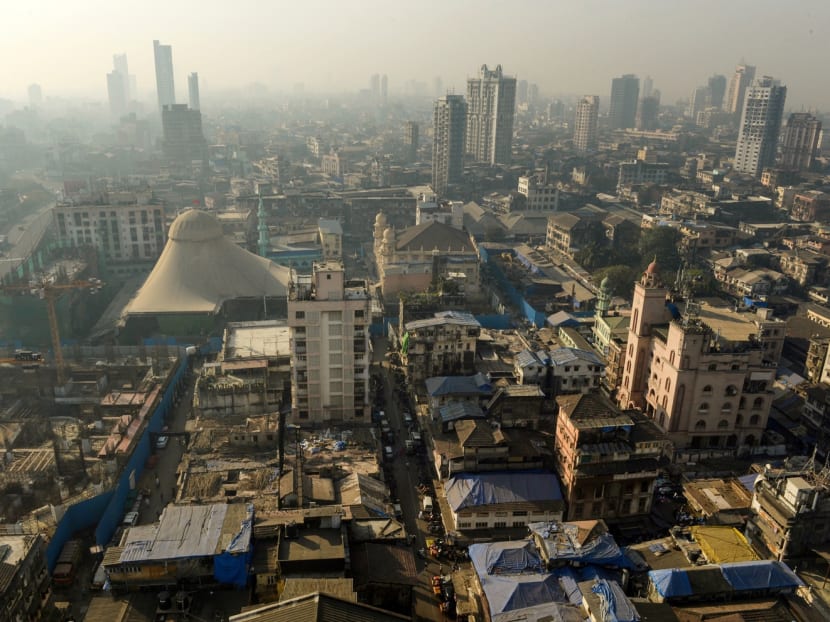S$864m project to re-house Shia Muslim sect in Mumbai
MUMBAI — Ms Farida Kachwala is vacating her family’s cramped home of 80 years, one of thousands receiving modern apartments through a project that hopes to transform Mumbai’s historic Bhendi Bazaar from a dilapidated ghetto into a slick Singapore-like enclave.

The Bhendi Bazaar area in Mumbai that is being redeveloped under the Cluster Development Act 2009 by the Saifee Burhani Upliftment Trust. It is budgeted to cost S$864 million. Photo: AFP
MUMBAI — Ms Farida Kachwala is vacating her family’s cramped home of 80 years, one of thousands receiving modern apartments through a project that hopes to transform Mumbai’s historic Bhendi Bazaar from a dilapidated ghetto into a slick Singapore-like enclave.
Up to US$600 million (S$838 million) is being spent to demolish hundreds of rundown low-rise buildings in the dirty colonial-era market and replace them with skyscrapers that will house 20,000 Dawoodi Bohras, a sect of Shia Muslims, who have made the area their home for decades.
“We have many problems here. It’s smelly because there’s sewage and garbage everywhere and the wooden stairs are really steep and dangerous. I’m so happy that we’re moving,” said Ms Kachwala.
The rehousing project aims to replace the decrepit structures and maze-like narrow streets, where hawkers sell everything from sunglasses to sweets, with gleaming towers and polished shopping arcades.
It is also hoped the scheme will help cleanse the neighbourhood of its underworld image. Dawood Ibrahim, who carried out the 1993 Bombay bomb blasts, lived in Bhendi Bazaar during the 1980s and Bollywood films often portray the area as a gangster hangout.
In India, it is common for tenants to stall development projects by refusing to move, or for homeowners to hold out for more cash, but this project is unique in that it is being driven by residents’ faith as much as their desire for 21st century amenities.
Bohras, whose women wear colourful ridas akin to hijabs while men sport gold and white caps, are a Shia Islamic sect who follow a religious leader they call his holiness. They originally arrived in western India from Yemen in the 11th century.
They often seek guidance from his holiness on many matters ranging from marriage to naming a child. The redevelopment was the brainchild of late leader Syedna Burhanuddin, who died aged 101 in 2014, a key reason why residents support it.
“Our families took his holiness Syedna’s advice and supported the project, so we hope it will be good for everyone involved,” said Mr Juzer Morbiwala at a transit home where he is being housed until his new apartment is ready.
Some 250 decrepit three- and four-storey buildings known as chawls — originally built for single male labourers in the 1800s and where residents often share toilets — are being razed and replaced with 17 high-rise towers across 6.7ha. About 3,200 families will receive new homes free of charge. Each will be a minimum of 350sqf in size, with private bathrooms and separate sleeping and living spaces.
The demolition and construction is taking place in nine phases. The first started about three years ago and the entire project is expected to be completed by 2025. The only buildings not being torn down are the area’s mosques.
Prime Minister Narendra Modi’s government is taking a keen interest, hoping that the cluster redevelopment method can become a model for urban renewal across India.
It is budgeted to cost 40 billion rupees (S$864 million) and a trust attached to the Bohra community’s governing body is providing the funding through donations. Money will also be raised by selling off four of the new towers that could stretch 60 storeys into the sky.
Mr Abbas Master, Saifee Burhani Upliftment Trust CEO, said the trust had acquired almost 90 per cent of properties but that a small fraction of residents were refusing to negotiate. “To uproot people and to bring them back is a challenge. It happens in places like China but in a democratic world I think this is the first example,” he told AFP.
Some 1,250 businesses will move from ramshackle shops and stalls down dingy lanes into shopping arcades above street level, which will be connected by pedestrian bridges.
Rapid development has altered Mumbai’s skyline in the past two decades and conservation architects lament the loss of another historic district and the personality attached to it.
“The entire fabric is going to get erased, the history, the artefacts. It’s going to have an impact on the social character,” architect Vikram Pawar told AFP. AFP





